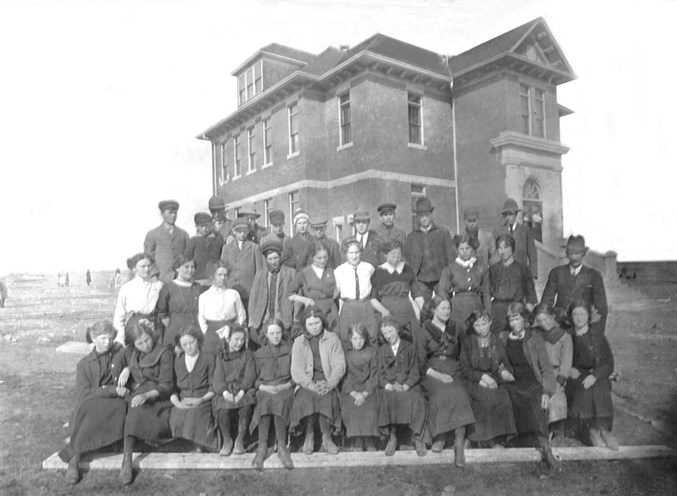School is in session at the Okotoks museum with an informative exhibit that shares the early days of the town’s oldest education facility.
Okotoks Upper School opened its doors to 35 students, Grades 7 to 11, on the hill overlooking the town in 1912.
Known today as École Okotoks Junior High School, Okotoks Upper School met the needs of a growing community with a population of 500, of which 180 were Grade 1 to 11 students attending Okotoks School where the courthouse now stands.
Thus the need for the new school on the hill.
“It was well named because it not only served the upper Grades, 7 to 11 initially, but it was built on top of the hill,” said museum specialist Kathy Coutts. “There were a couple of farms further to the west, but it really was the first significant building on top of the hill.”
Details about the early years of the grand
two-storey brick school, including photographs, yearbooks and memories from former staff and students, are on display on the second floor of the Okotoks Museum & Archives until Aug. 30.
“It’s fun to look at old photos, even though you may not know anybody in the picture, and look at how styles have changed,” Coutts said. “Quite a few memories relate to vice-principal Lambert Checkley, who was known to throw chalk at the kids and had precise aim, whether to get their attention or if they were misbehaving.”
A memory shared by former student Audrey Hoiland in 1939 recalls when war was declared against Germany.
She recalls staff and students being frightened, and many later going off to fight in the Second World War.
Okotoks School, a two-storey brick building that was renamed Okotoks Lower School in 1912, had offered education to Grades 1 to 11 students for 12 years before there was a need for a larger school, explained Coutts.
“When it was getting overcrowded they used space where they could find it, including the basement of the Masonic Hall,” said Coutts.
“The lower school was linked to the upper school by a long flight of wooden stairs. A lot of memories relate to the long stairs that people had to climb to get to the school.”
With natural gas coming to Okotoks in 1912, Okotoks Upper School was one of the first Alberta schools to have natural gas heating, Coutts said.
In those early years, few children attended school beyond Grade 8 so it wasn’t until the 1930s that Okotoks Upper School offered Grade 12, said Coutts.
The school boasted four large rooms and outdoor biffies before it was expanded in 1957.
“Because of overcrowding they needed additional room,” Coutts said. “A lot of the country schools were closing and kids from the country were being bused in town.”
To help meet the growing need, nearby one-room schoolhouses no longer being used were brought on site – equivalent to the modern-day portable, said Coutts.
Cameron Coulee School southwest of Okotoks was used as a shop for the boys and Panima School west of Okotoks was used for home economics, she said.
Okotoks Upper School saw another significant addition in the early 1970s, specifically a large one-level extension to the east side of the school used for Grades 3 to 6 because Okotoks Lower School was getting crowded.
A census taken in 1971 showed the town’s population at 1,247, said Coutts.
Okotoks Upper School was renamed Okotoks Junior/Senior School and later Okotoks Junior High School when the Foothills Composite High School was built in 1984.
Coutts invites members of the public wanting to loan photographs or share memories of Okotoks Upper School to add to the exhibit during its duration.
Okotoks Museum & Archives is open Monday to Saturday 10 a.m. to 5 p.m. and Saturday from noon to 5 p.m. Admission is by donation.




